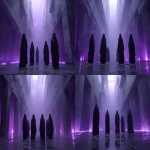Explore the Best AI Image Gallery

Beyond the Screen: How VR and AR Are Reshaping Gaming and Creativity
The gaming industry has always been a pioneer, pushing technological boundaries and captivating players with immersive experiences. Now, virtual reality (VR) and augmented reality (AR) are ushering in a new era of interactive entertainment, blurring the lines between the digital and physical worlds.
A New Dimension for Gamers
VR transports players into entirely simulated environments, allowing them to interact with digital objects and characters as if they were physically present. This creates a sense of presence and immersion unmatched by traditional gaming experiences. From exploring fantastical landscapes in role-playing games to engaging in realistic combat simulations, VR offers unprecedented levels of engagement and interaction.
AR, on the other hand, overlays digital content onto the real world, enhancing our perception of reality. Imagine playing a game where virtual monsters appear in your living room or using your smartphone to explore a historical site with interactive 3D reconstructions. AR seamlessly blends the physical and digital, offering exciting possibilities for both entertainment and education.
Transforming the Creative Landscape
The rise of VR and AR has had a profound impact on the creative industries. Game developers are now equipped with powerful tools to design intricate virtual worlds and create truly immersive experiences. Artists can utilize these technologies to showcase their work in innovative ways, while filmmakers can experiment with new storytelling techniques.
Potential Applications Beyond Gaming
The potential applications of VR and AR extend far beyond the realm of gaming. Here are just a few examples:
- Education: Immersive simulations can provide students with hands-on learning experiences in various fields, from history and science to medicine and engineering.
- Healthcare: VR can be used for pain management, rehabilitation therapy, and medical training. Surgeons can practice complex procedures in a virtual environment before operating on patients.
- Architecture and Design: Architects and designers can use VR to create virtual walkthroughs of buildings and products, allowing clients to experience their creations before they are built.
- Retail: AR can enhance the shopping experience by allowing customers to virtually try on clothes or visualize furniture in their homes.
Ethical Considerations
As with any powerful technology, VR and AR raise important ethical considerations:
- Privacy: The use of sensors and cameras in these technologies raises concerns about the collection and use of personal data. It is crucial to ensure that user privacy is protected.
- Addiction and Mental Health: Prolonged exposure to immersive virtual environments can have potential negative impacts on mental health and well-being. It is important to promote responsible use and set boundaries.
- Representation and Bias: VR and AR experiences should be inclusive and representative of diverse cultures and perspectives. It is essential to avoid perpetuating harmful stereotypes or biases.
Future Trends
The future of VR and AR is brimming with possibilities:
- Increased Accessibility: As technology becomes more affordable and user-friendly, VR and AR will become increasingly accessible to a wider audience.
- Convergence with Other Technologies: We can expect to see greater integration of VR/AR with artificial intelligence (AI), machine learning, and the metaverse, creating even more immersive and interactive experiences.
- New Use Cases: The applications of VR and AR will continue to expand into new industries and sectors, revolutionizing the way we work, learn, and interact with the world.
Conclusion
VR and AR are transforming the gaming industry and beyond, offering unprecedented levels of immersion, creativity, and interactivity. While ethical considerations must be carefully addressed, these technologies hold immense potential to revolutionize how we experience the world and shape our future.
















](https://images.ai-img.art/thumbnails/150/1ce1e6bd70605ae20fb18eb21544092347b1baebb547304b9002eb707483f172.webp)


](https://images.ai-img.art/thumbnails/150/461af9b1ecfbca79f228584c0f3751118c0f696486cadcccf30ab2600b74bc0b.webp)








](https://images.ai-img.art/thumbnails/150/1f5b798b3922304bf6c37ce90b7a9290370c44a8bcfbfb0180b93faa4b02f73a.webp)










](https://images.ai-img.art/thumbnails/150/c9437d9698a6c6c26564883d095b411feaeda2095b19e025e8c1668085441c5c.webp)









